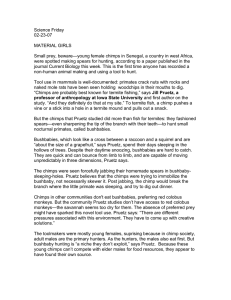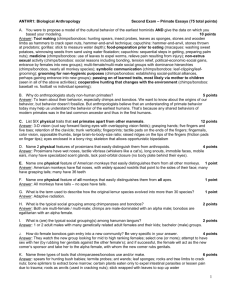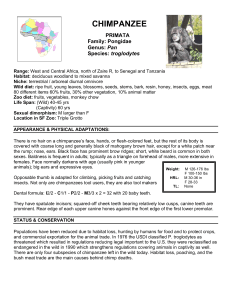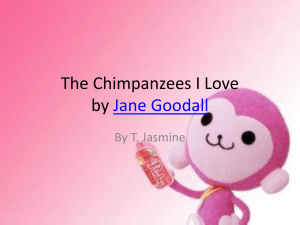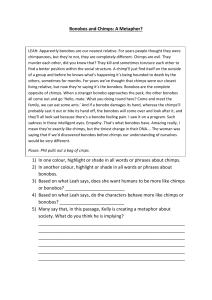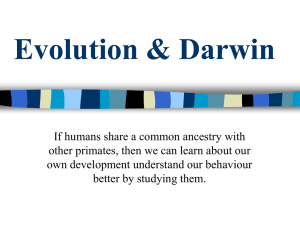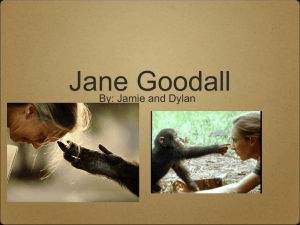Primate Behavior
advertisement
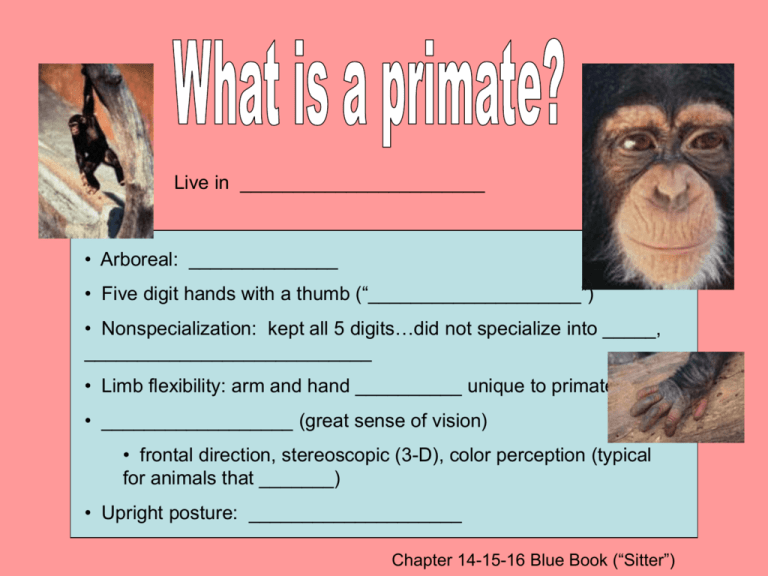
Live in _______________________ • Arboreal: ______________ • Five digit hands with a thumb (“____________________”) • Nonspecialization: kept all 5 digits…did not specialize into _____, ___________________________ • Limb flexibility: arm and hand __________ unique to primates • __________________ (great sense of vision) • frontal direction, stereoscopic (3-D), color perception (typical for animals that _______) • Upright posture: ____________________ Chapter 14-15-16 Blue Book (“Sitter”) ________ mill years. Smaller, _______, _________, “furry” Lemurs: size of a ______, __________, found in ________________ only, long furry tail, feed on ___________________, live in structured groups Lorises: _______, slow moving, hunt ______, no tail, eyes ________________ ______ mill years. Larger than prosimians, prominent skulls, more ______________, full color 3-D vision, _______ nose Howler Monkey: ____________, diurnal, rain forest habitat, feed mainly on leaves. ______________ tails (“grasping” appendage). Loudest calls among primates (i.e. the name!!)…consequently, very low ______________ encounters. Squirrel Monkey: smaller, __________, white face, dark eyes, long ________________ tails used for balance, abundant food in leaves, fruits, flowers, and even insects…consequently – widespread _____________ ___________ group of primates, African in origin. Guenons: (Blue Monkey) Small (_______lbs), arboreal, omnivores, live in troops of about ____ with one ___________ male. Larger sexual __________________(physical difference btw sexes) due to competition among mating males Non-dominant males live __________ and will mate with wandering females of a troop. Large variation in __________ patterns Baboons: Largest monkey species (_______lbs). adapted for walking on the ___________ (non-arboreal) using _____ limbs. Classic ______________ difference btw male and female. Large muscles, long tail, large teeth and jaws…used only for _______________ “display”. Will actually stand and defend against predators!! Complex social organization…both male (“_______”) and female have rank. Males leave the troops around age 4, females stay (prevents __________) Highly successful _________ species. Hairless “_________________” on their butts…bare callous to sit Apes: larger _________, no tail, Evolved from Old World Monkeys about _____ million years ago. Gibbons: 3 feet tall. Strictly _________, mostly herbivorous. Walk upright (_______________), but mostly move by _________________ (“swinging). Can leap ____ feet and brachiate at _____mph (fastest of all primates!!) Thumbs are small are useless. Hands are used like _________ for swinging quickly ________________ couples live with offspring (like human!!). Leaves the family after 6-8 years. Very _________ sexual dimorphism, due to low _____________________ among males Non-confrontational, and due to their speed, are rarely preyed upon. A. Orangutans • first of the Great Apes to evolve (___ million years) • ____________ tree dwelling animal (arboreal) in the world (______lbs) • Shy solitary animal, difficult to study naturally. Male and female socialize only to mate. • Diet limited to hard to find fruits…better to be on you own! • Can grasp with their _______ B. Gorillas • only discovered in _____ century by European scientists • Contrary to myth, gorillas are the _____ and _________ of all primates …in spite of _________ lbs body standing over 6 feet tall!! • Live in small family groups of about _________. One large dominant silverback male leads the troop. Females move out after maturity (no inbreeding) • Herbivorous – eats ________lbs of vegetation per day!! • Cannot grasp with their feet….usually walk on all fours…NON-arboreal. • Chest pounding may indicate ___________, ______________, ________, ______________, or ______________________. • Yawning is a _________________ gesture • No “rump pad” (ischial callosites) – need to sleep in ___________________ • Threat display: (usually accompanied with loud screams and roars) • 1. __________ Charge: charge past adversary • 2. __________ Charge: charge and stop short • 3. ___________ Charge: runs directly into adversary Dian Fossey: Gorilla in the Mist (1998) c. Chimpanzee • share over _______ of human genes…share common ancestor. • Jane Goodall, Gombe, Tanzania (1960)…witnessed __________________ and _______________ • _________ lbs. Only ______________ left in the wild. • Usually NON-arboreal • UNLIKE baboons, ________ stay with the group while ________ migrate. • Huge array of facial expressions and vocalizations (________________) • Males hunt monkeys in groups, each with a specific _____ (driver, blockers, chasers, ambushers) • Chimps at war: they may seek out and kill members of a different community…not eaten for food. Only primate (other than human) to commit “___________”. Suggested that it’s for territorial expansion…war??? D. Bonobos • used to be called _________ chimps, but they’re not much smaller than chimps • slimmer _____, narrower __________, longer ____, smaller ________ • Inhabit different areas in the wild, so they don’t _______ with chimps. • enjoy ________ (unlike chimps)…also have small webbing between toes! • walk _______________ more easily than chimps • Society dominated by _________________ (unlike chimps!) • Like humans, bonobos are ________________ active all the time • Love, Not War: ___________ is used to maintain harmony within the group! • Sex is used to avoid aggression, reconcile, or relieve tension (even between _____________________ bonobos Criteria traditionally used to show the evolution of human intelligence. However, it no longer is used to determine intelligence because it is NOT linked with the ______________ or ________________ of the Central NS. It’s an ___________ mechanism for animals to get food rather than changing their physical ________________. We change our _____________ rather than our ____________ (generalization rather than specialization) Use of a stone to crack open a nut Use of a stick to access a termite mound _________________ learning occurs primarily in primates, but otherwise is actually quite _________ in the animal kingdom (although does occur in a few others, such as some mammals and birds. It is an ____________, _________, and __________ way to function within your environment. The passing on of behaviors through generations may result in __________________. For most animals, it is ____________ (you’re born with it). These instinctive responses protect animals from _______________. Lots of research still being done on this!! ________ versus ______. Important Early Childhood Experiences: • Contact Comfort; touch, warmth, protective security • Peer Relations; social isolation led to ____________________, sexual _________, rejection by others…also, rocking, swaying, selfmutilation…never learned to __________________ in a very social society. • Mother Deprivation; ____________ ____________ would sit on the infant, throw it against the wall, or try to ____ it * Harry Harlow’s work Mother deprivation continued • Infants who were raised by __________ then separated from them became ___________________ _______________________. (Anaclitic depression) •Normal development was ________ down on all levels. •How many of these findings can we generalize to humans? •Play; may be ________, ___________, or ____________. •Costs; use ______, risk ____ •Benefits must outweigh costs…healthy development of the ________ and ______________________. (Greater stimulation led to larger _______ with more ________.) • Practice movements needed for ______________…deer vs. mountain lion playing. Explore in safety. Practice _______ behaviors. Stimulates the development of the nervous system and __________ abilities. And maybe just for ______!
